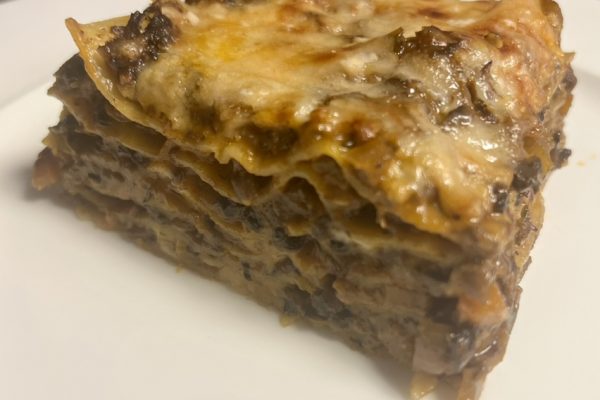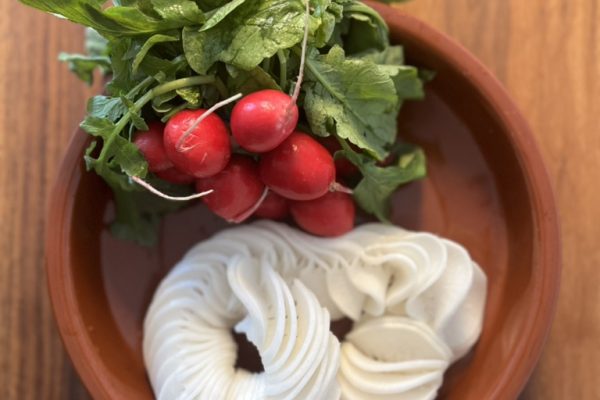Dal Makhani, which translates as “buttery dal”, is an iconic dish from Punjabi cuisine. And our favourite dal of all. However, we also recommend our classic mung dal tadka and this recipe for khichdi.
It takes much longer to prepare than other dal, which is why it is eaten more often in restaurants than at home. For us, it’s the other way round 😉
This dish is best when you give it plenty of time over a lower heat. Here we give minimum instructions for the “quick” version, which you should not go below.
You absolutely need urad dal (also known as urd or urid), specifically whole, black urad beans. Unfortunately, they are not always easy to get hold of and whereas a few years ago we could still buy them in Asian markets around the corner, nowadays we unfortunately have to order them online. But then we buy a few kilos at once, as such pulses keep almost forever. Red kidney beans are also a must – and by no means from a tin, but also dried. In some recipes, other types of lentils or beans are added, but we stick to the purist approach with this dish.
The urad dal in particular must first be washed very thoroughly. To do this, pour plenty of water over a mixture of black beans and kidney beans and rub the pulses together between your hands. The water quickly becomes cloudy and needs to be changed. When it remains almost clear, leave the beans to soak in it for at least 12 hours.

The beans are then poured through a sieve and placed in a large pot on the cooker with fresh water. The water should be 2 – 3 cm above the beans (we have often seen how this is measured with the first joint of an index finger in India).

In some recipes, garlic and/or spices are added at this point, sometimes even salt. In our experience, however, this is of no benefit and we hardly ever salt pulses at the beginning because it prolongs their cooking time.
As soon as the water boils, foam will rise. This should be removed using a small sieve or ladle. The beans can then be cooked over a low heat with a lid, gently simmering is sufficient. This takes 1 ½ to 2 hours.
Many people cook dried pulses in a pressure cooker because it is much quicker. However, the skin of the urad dal may come off almost completely, which can give the dish a slightly different consistency.
The beans are cooked when you can easily crush them between two fingers. For the typical creaminess of this dish, some of the cooked beans are now also mashed in the cooking liquid, which can easily be done with a potato masher. If you don’t have such a tool, simply use a wooden spoon and the inside wall of the pot. In total, about 20 % of the beans should be mashed, the others remain whole.

Now you need a whole range of ingredients, shown here clockwise in the order in which they are used, starting at 12 o’clock:

Clarified butter or ghee is heated in a large saucepan or high-sided braising pan, then cumin seeds are added and roasted for half a minute until they begin to smell intensely fragrant.

Finely grated ginger and garlic are added immediately. If you cook Indian food frequently, you can also buy ginger garlic paste in a jar and keep it in the fridge, which saves a lot of time.

Ginger and garlic are only briefly roasted, they must not take on any colour. After another half a minute, add tomato puree, turmeric, ground cumin and coriander as well as chilli powder. We recommend using the excellent Kashmiri chilli, which has an intense flavour without making the dish overly hot. It also contributes a beautiful deep red colour.

Allow this mixture to simmer gently over a medium-high heat for just under 10 minutes so that the flavours develop fully and the tomatoes lose most of their liquid. In Indian cooking, it is often said that you should do this until the oil or clarified butter separates from the tomatoes – and this is how we always do it.
Then stir in plenty of butter and season with a teaspoon of salt for the first time.

The cooked beans are added, everything is stirred thoroughly and simmered over a low heat with the lid on for at least 15 minutes – longer is always better. We like to give the dish twice as much time at this point and find that this intensifies the flavour even more. However, it should be stirred occasionally so that the beans don’t burn on the bottom of the pan.

Even more spices are now added, namely the spice blend garam masala (which contains nutmeg, cloves, bay leaf, cinnamon and cardamom) and kasoori methi. That is dried fenugreek leaves, which contribute an aroma and flavour associated with typical curry powder. Kasoori methi is placed in the palm of one hand, covered with the other and then rubbed together over the pot, finely crushing the dry leaves.

The dal has to simmer gently for at least another 15 minutes and we like to give it twice as much time again.
Finally, stir in cream and season to taste with salt.

Before serving, the dal should be left to rest for no less than 15 minutes, with the lid on the lowest heat, just to keep it warm. Then this delicacy is ready and can be enjoyed with rice or flatbread. We don’t eat anything else with it and concentrate fully on this little miracle of flavour.

Enjoy.
And may the taste be with you.
Ingredients (for 4 people):
240 g whole urad beans
60 g kidney beans
2 tbsp ghee (clarified butter)
2 tsp cumin seeds
2 tbsp ginger and garlic paste
400 ml strained tomatoes
1 tsp turmeric
1 tsp ground coriander
1 tsp ground cumin seeds
1 – 2 tsp Kashmiri chilli
80 g butter
2 tsp garam masala
2 tbsp dried fenugreek (kasoori methi)
250 ml cream
Salt




